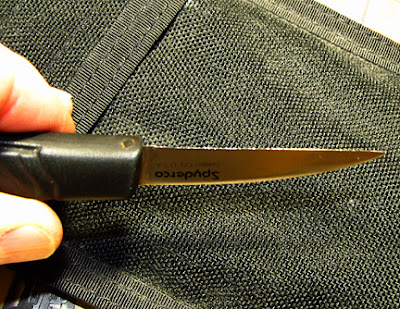 |
| The large prototype folding Karambit |
Originally, like so many
martial art weapons, the karambit originated in southeast Asia. Inspired by the
claws of big cats, the natives initially used this design for mundane
activities, like raking roots, gathering threshing and planting rice. Over time. circumstances forced the
development of farm and every day implements into weapons of self-defense.
“The karambit is held with the blade
pointing downward from the bottom of the fist, usually curving forwards however
occasionally backwards. While it is primarily used in a slashing or hooking
motion, karambit with a finger ring are also used in a punching motion hitting
the opponent with the finger ring. Some karambit are designed to be used in a
hammering motion. This flexibility of striking methods is what makes it so
useful in self-defense situations. The finger guard makes it difficult to
disarm and allows the knife to be maneuvered in the fingers without losing
one's grip.
The short Filipino karambit
has found some favor in the West because
such proponents allege the biomehanics
of the weapon allow for more powerful cutting strokes and painful
"ripping" wounds, and because its usability is hypothesized as more
intuitive, though there continues to be debate about this matter.”
It takes hardly any effort to find self-promoting YouTube
videos of how to use a fightin’ karambit.
Any of these complete videos can be purchased, …our operators are
standing by…
The problem with fixed knives is they are not easy to
conceal, a necessary condition of modern society. Shadow Tech
has been making fixed blade karambits for some time now. They are currently, in a secret
laboratory/dojo, developing two folding karambits. And joking aside, they look pretty
great. I’ve only seen prototypes but
they were very close to production models.
 |
| Make that 2 to go, please. |
I expect a there will be a little
tweeking before and possible after release.
After all it is only mythology in which Venus springs forth from the
ocean in all her perfection. I do know
the knives will be made from Crucible’s 154CM steel. Some of the best knife companies use 154CM
steel for their blades. ST is using it
for liners, liner lock and clips also. The
clip will be reversible and the knife rides tip up. At least that was the plan when John and I
talked about it.
 |
| Many knives, many fine knives have only a portion of the liner lock behind the blade |
The liner lock will throw its
complete thickness behind the blade spreading out the force of folding over a
wide surface. My limited experience
suggests that may require a little more effort on your part to unlock the knife. Pushing the liner lock over may require you
to dig your thumb a little deeper in the lock, but you can image the painful
consequences of having the lock fail.
ST tells me they will have
two sizes, a large aggressive blade,
 |
| Large size |
And a smaller blade.
 |
| The small size |
John tells me there will be several ways of snagging the
blade’s opening stud and/or geometry to open the blade as you draw it from your
pocket. That’s very cool.
Still remember what one veteran told me:
“I carry in my pocket.
If there could be trouble I move the knife from my pocket to behind my
belt. If I think there is going to be
trouble, the unopened knife is carried in my hand.”
A karambit has the potential to increase even an unskilled person’s survival potential. Give that and Shadow Tech some consideration.
Find your Shadow Tech at https://www.stknives.com/








